- Dell Boomi vs MuleSoft
- Mulesoft Interview Question And Answers
- Introduction to the MuleSoft Anypoint
- Mulesoft Tutorial
- Mulesoft vs Zapier - Key Difference
- Mulesoft vs WebMethods - Key Difference
- Mulesoft vs Alteryx - Key Difference
- What is Mulesoft
- Mulesoft vs Informatica - What's The Difference?
- Mulesoft Architecture
- MuleSoft API Led Connectivity
- MuleSoft vs TIBCO - The Key Differences
- Mulesoft Connectors
- What is MuleSoft Developer?
- How to Install Anypoint Studio on Windows
It’s no wonder if you have a question about why the integration of tools is essential. The answer is simple. We integrate different applications and tools to simplify data exchange and improve communication. Also, we switch between tools very often. By integrating tools, we can avoid switching between tools and save significant time.
Know that Mulesoft is an integration platform for APIs and SaaS applications, whereas Salesforce is a robust CRM tool. Mulesoft offers efficient API solutions, which help to minimize hardware and coding requirements. On the other hand, Salesforce simplifies sales and marketing processes, digs deeper into customer data to generate valuable insights, and accelerates business growth.
Mulesoft and Salesforce are the popular platforms widely used across many companies. No wonder many Fortune 500 companies employ Mulesoft and Salesforce to streamline their business operations and boost productivity. If you polish your skills on the tools, then top companies will open doors for you. For example, you should have good expertise in integrating tools and simplifying tasks.
Keeping this in mind, MindMajix subject experts designed this blog to teach you how to make a hassle-free Mulesoft integration with Salesforce in a step-by-step method.
Let’s check it out!
Table of Contents
- What is Mulesoft
- What is Salesforce
- Prerequisites for the integration
- Mulesoft integration with Salesforce
- Best practices in Mulesoft integration with Salesforce
- Benefits of Mulesoft integration with Salesforce
- FAQs
- Summary
What is Mulesoft?
Before diving into the integration of Mulesoft and Salesforce, we will examine what Mulesoft is.
Mulesoft is a popular integration platform that helps businesses to collaborate with other platforms. Mulesoft connects with external applications in a simple plug-and-play mode. Yes! It is an easy-to-use tool that supports quick integrations.
Know that Mulesoft is a Java-based platform with which you can organize data, automate business processes, and improve customer experience. The great thing about Mulesoft is that it allows reusing components, improving productivity. Besides, it provides enhanced security to data and applications.
| Do you want to get certified and build your career in Mulesoft? Then enroll in "Mulesoft Online Training" This course will help you to achieve excellence in this domain. |
What is Salesforce?
Let’s take a glance at what is salesforce.
Salesforce is essentially a cloud-based customer relationship management (CRM) platform that brings sales, marketing, service, and IT teams to a single point. It allows teams to work together and be more intelligent. Also, teams can communicate with their customers efficiently and provide them with an improved customer experience.
Salesforce maintains a unified data platform so that different teams can access data in a single view in one place seamlessly. It is a tool that generates valuable insights by analyzing customer data in-depth. As a result, companies can make concrete decisions and boost productivity. Also, Salesforce helps improve team collaboration, increase sales, and drive better business outcomes.
Hope you have gained some basic ideas about Mulesoft and Salesforce. Let’s jump into the integration part now.
Prerequisites for the integration
Before integrating Mulesoft with Salesforce, we must know the requirements. If you have made all the requirements ready, it will help you complete your integration process quickly.
Let’s now look at the prerequisites in the following.
- Installation of Anypoint Studio 7.15 version (Product: mule and Studio)
- Installation of Salesforce software
- Knowledge of API reuse, API-led connectivity, and salesforce integration patterns.
- Exposure to salesforce workbench, properties, objects, and object parent-child relationship.
So, ensure that you have satisfied the above requirements without leaving anything. Now you are ready to make seamless Mulesoft integration with Salesforce.
Related Article: SalesForce Integration and Environment in Cloud Computing
Mulesoft integration with Salesforce
Mulesoft integration with Salesforce triggers excellent outcomes since this integration allows Salesforce to gather accurate data from multiple applications.
Following is the step-by-step procedure to integrate Mulesoft with Salesforce. Here we go:
1. Creating a Mulesoft account:
First, start by creating a Mulesoft account on your machine.
- Install Mulesoft on your machine using the below link.
- Create a new project in Mulesoft.
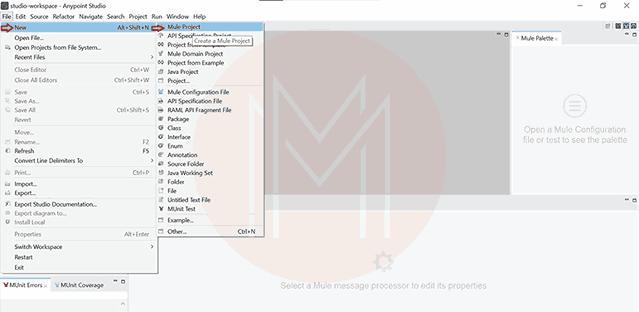
Then, enter the project name and then click the finish button.
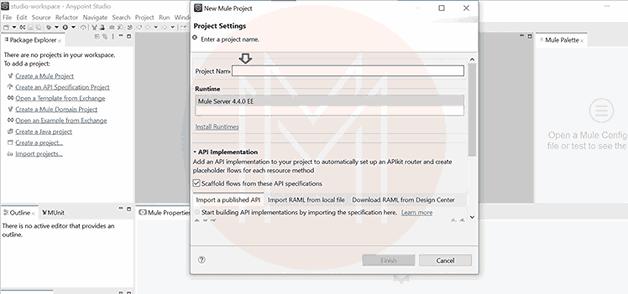
Once it is over, move on to installing a Salesforce account.
2. Creating a Salesforce account:
If you are wondering how to create a Salesforce account, the steps below will guide you.
- Now, we can create a Salesforce account using the below link. Enter your details to open a trial version of Salesforce.p8
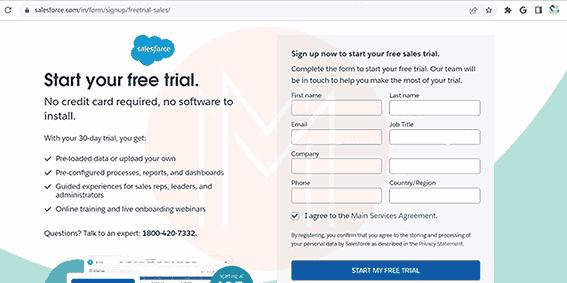
- Click your profile in the right corner of the page and click your profile.
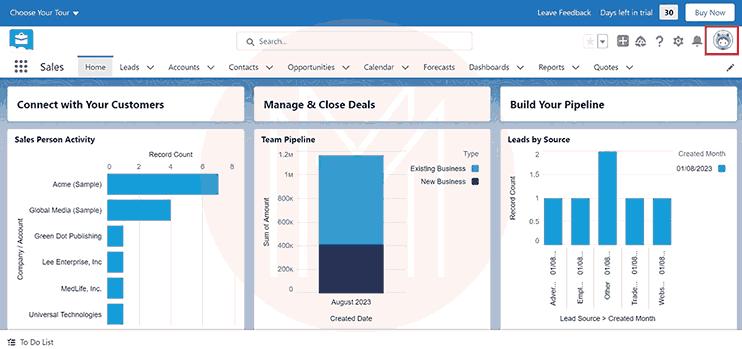
- You can find the ‘settings’ as shown in the below image. Click the settings.
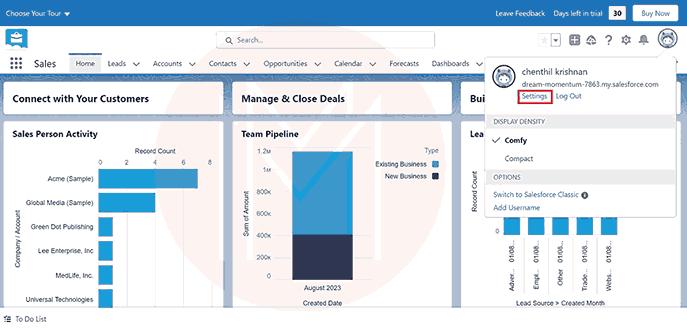
- You will be directed to the ‘My personal information’ page. Then, navigate to ‘reset my security token’ under the ‘my personal information’ category.
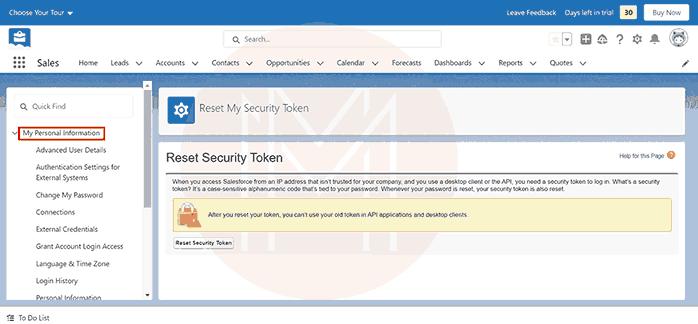
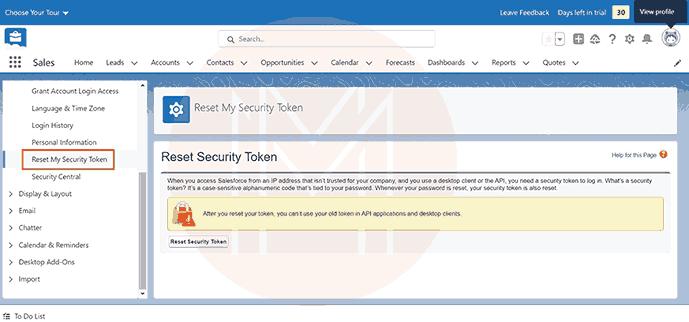
- Once you click the 'reset for security token' button, a new security token will be sent to your registered email address.
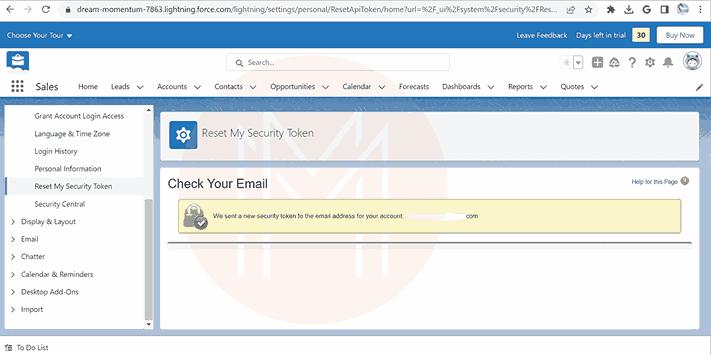
Well! Now we have installed Mulesoft, and Salesforce accounts as best as possible.
3. Configuring Mulesoft
It's now to configure Mulesoft. Follow the below steps closely to configure Mulesoft neatly.
- Go to the Mulesoft palette, click ‘HTTP,' and drag the listener into the workspace.
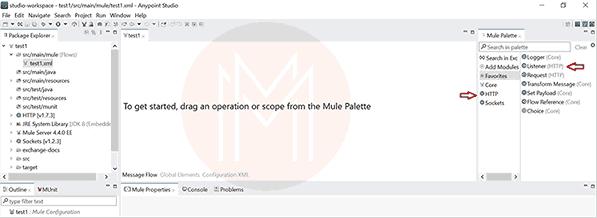
- After dragging it, you will get the workspace as shown below.
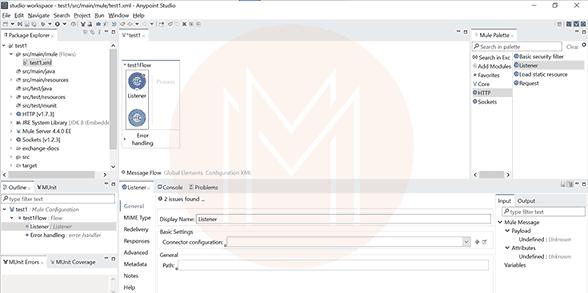
- Now go to ‘global elements’ located at the lower part of the test1 console and then click the ‘create’ button.
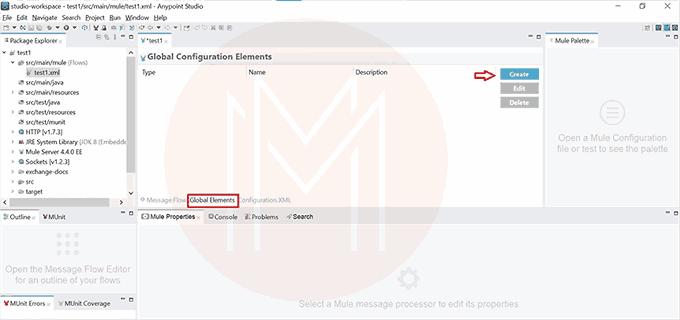
- A new pop-up will appear, as shown below. Navigate to ‘connector configuration’ and click on the left-side arrow.
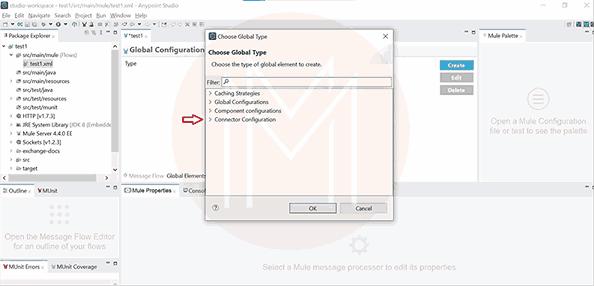
- It will open a list of items in which select the ‘HTTP listener config’ and then click OK.
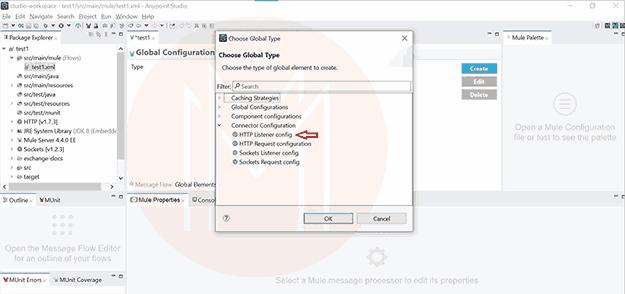
- A new pop-up will emerge, as shown below. Then click the OK button.
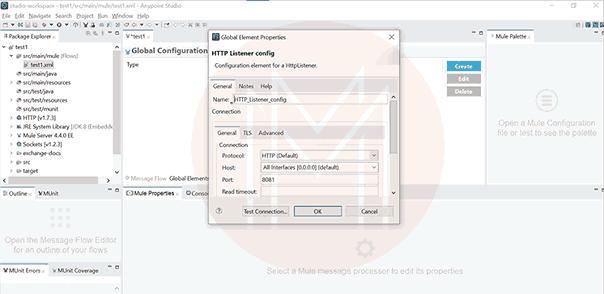
- The ‘HTTP listener config’ will be added to the global configuration elements, as shown below.
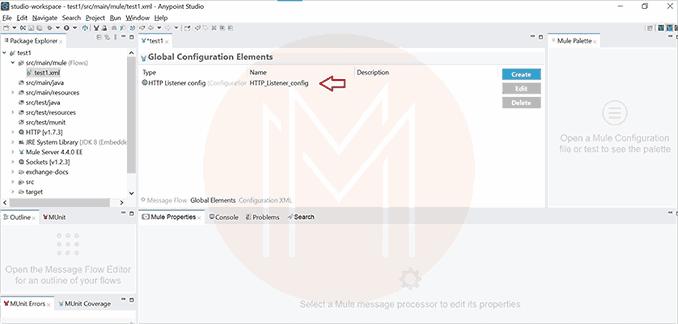
- Again, go to the ‘Mulesoft palette’ and click ‘Add Modules’. Now, drag and drop ‘Salesforce’ into the items of the Mule Palette.
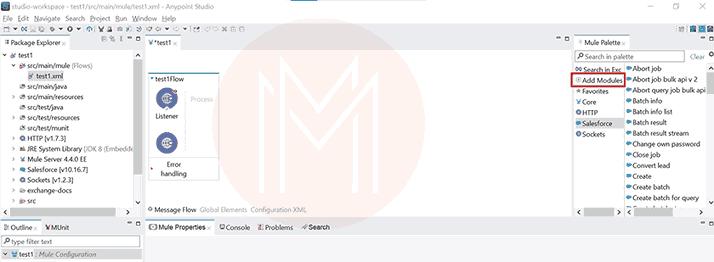
- Go to ‘Mule Palette’ and click the 'search in Exc’ item.
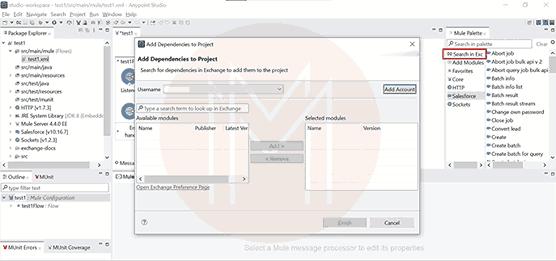
- A new pop-up will emerge as shown in the figure where click’ add account and then click configure on the top of the popup. Then Choose the ‘Anypoint Platform as authentication’ method.
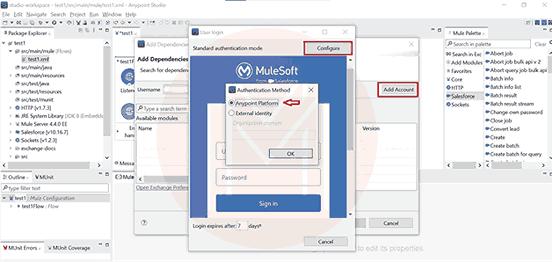
- Enter your Mulesoft credentials in the required fields and click the OK button.
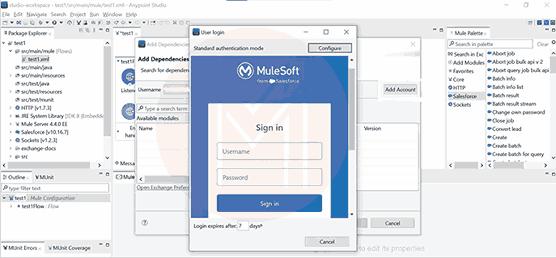
- Also, click the configure button on top of the user login. Then, select the Anypoint platform and click OK.
Right now, we have completed configuring Mulesoft. Let's move on to the next step –integration.
4. Integrating with Salesforce:
In this section, we will go over the steps to integrate Salesforce with Mulesoft.
- Then type ‘Salesforce’ in the field as shown in the below image. You will see a list of salesforce products where select salesforce connector.
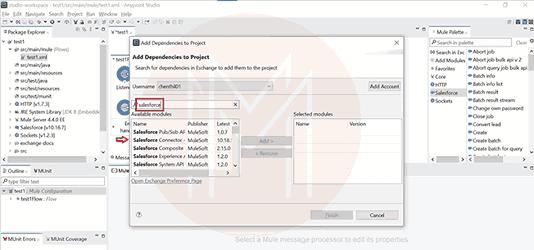
- Add the element and click the finish button to complete.
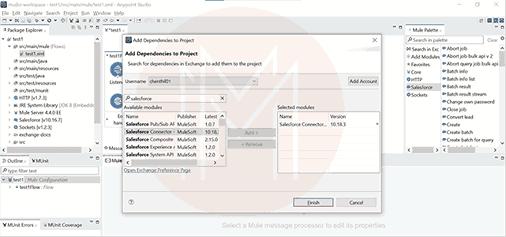
- After that, you can ensure whether the test connection is successful.
- Then, drag the ‘query’ from the salesforce modules in the mule palette. Also, add ‘salesforce_config’ in the basic settings, as shown in the below image.
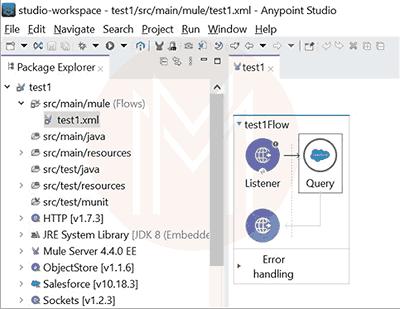
- You can now type a salesforce query, as shown in the image below.
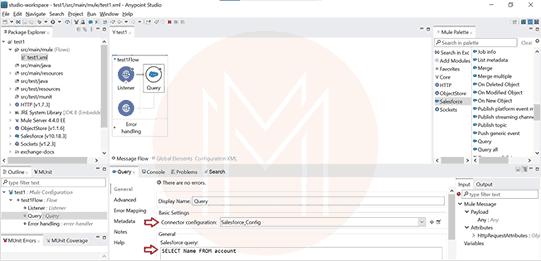
- Then select query and then run as ‘Mule Application’.
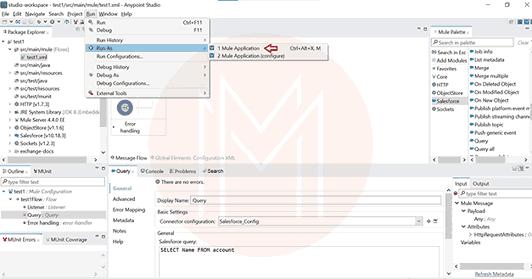
- Finally, you can find the application status as deployed in the console.
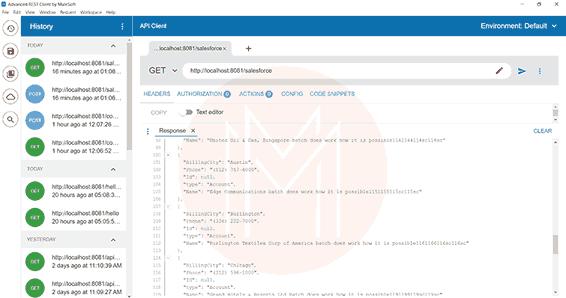
Kudos! You have successfully integrated Mulesoft with Salesforce.
Best practices in Mulesoft integration with Salesforce
Know that there are some best practices for performing mulesoft integration with Salesforce. If you make use of them, it will help you to integrate Mulesoft with Salesforce in the best way.
Let’s take a look at them.
- Complete understanding of end-to-end business processes and requirements.
- Segregate the responsibilities between Mulesoft and Salesforce sharply. For example, Mulesoft will gather, transform, and insert it into Salesforce. On the other hand, Salesforce handles the automation of data processing.
- Create mappings to expose data flow between Mulesoft and Salesforce. It will help to identify the potential issues in data transfer.
- Additionally, you can map documents between external systems and Salesforce. This approach helps define Mulesoft's scope, data transformations, etc.
You will undoubtedly realize the best results if you leverage the above-mentioned best practices.
Benefits of Mulesoft integration with Salesforce
Users can reap some key benefits because of Mulesoft's integration with Salesforce.
Let’s go over the benefits in the following.
- This integration unifies data in a single platform with the help of pre-built connectors.
- As this integration reduces manual coding drastically, the occurrence of errors in coding is also reduced.
- It simplifies the coding process. In other words, it reduces manual coding efforts.
- This integration speeds up upgrades, reducing time and money significantly.
- It allows companies to move from cloud to multi-cloud platforms effortlessly. The important thing is that there is no need to rebuild applications.
- It enables increased connectivity of data sources and SaaS applications.
- This integration improves security through robust access control and threat protection.
Of course! The benefits are enormous and highly useful to users.
Mulesoft integration with Salesforce FAQs
1. What is the importance of integrating systems?
We integrate systems or tools to sync data and simplify communication. We can get a single view of data of multiple systems through integration.
2. Mention the different types of salesforce integration.
Jotted down are the different types of salesforce integration.
- API integration
- Business logic integration
- Data integration
- User Interface integration
3. Name the different types of mulesoft APIs.
Following are the different types of Mulesoft APIs.
- Process API
- System API
- Experience API
4. Can I leverage Mulesoft for integration?
Yes! You can use Mulesoft to make seamless integration. It simplifies data exchange and communication.
5. Mention the different types of Mulesoft deployments.
Below are the different types of Mulesoft deployments.
- CloudHub
- On-premises Mule instances
- Anypoint Runtime Fabric
6. What is the goal of salesforce integration?
Salesforce integration aims at connecting businesses as well as customers. You can achieve enhanced visibility across sales and marketing, commerce, and service activities with Salesforce integration.
7. What data types can we typically integrate into Salesforce?
Attachments, custom fields, Descriptions, and comments are data types integrated into Salesforce.
Summary
- Integrating tools simplifies teams’ communication and data exchange
- Mulesoft is an integration platform for APIs and SaaS applications.
- Salesforce is a CRM tool that helps to accelerate sales and marketing processes and improve customer experience.
- Mulesoft integration with Salesforce creates a unified data platform by syncing data.
- This integration reduces coding requirements and improves productivity.
Conclusion
In this blog, we hope the step-by-step procedure might have helped you make effortless Mulesoft integration with Salesforce. Sure! You might have gained better hands-on experience in integrating Mulesoft with Salesforce. Further, you can opt for professional training to improve your technical expertise on Mulesoft and Salesforce. MindMajix is a pioneer e-learning provider that offers courses on Mulesoft and Salesforce. You can feel free if you want to make any suggestions or raise any questions. You can use the comments section for the same.
 On-Job Support Service
On-Job Support Service
Online Work Support for your on-job roles.

Our work-support plans provide precise options as per your project tasks. Whether you are a newbie or an experienced professional seeking assistance in completing project tasks, we are here with the following plans to meet your custom needs:
- Pay Per Hour
- Pay Per Week
- Monthly
| Name | Dates | |
|---|---|---|
| MuleSoft Training | Dec 13 to Dec 28 | View Details |
| MuleSoft Training | Dec 16 to Dec 31 | View Details |
| MuleSoft Training | Dec 20 to Jan 04 | View Details |
| MuleSoft Training | Dec 23 to Jan 07 | View Details |

Satish is a Data Management and Governance Practitioner with over 16 years of IT experience supporting enterprises to develop and optimize solutions that result in high value. He has an experience spanning across Data Warehouse ETL leveraging Informatica PowerCenter & Custom Tools, Databases like Teradata, Oracle, MS-SQL & Greenplum, Integrations design with MuleSoft, and Implemetation of Data Catalog, Governance and lineage applications such as Alation, Collibra & Manta at an Enterprise level. Satish was associated with GE, Dell & E2Open with successful implementation of Supply Chain integration solutions for several AMER & APJ region organisations. Currently, he is a Tech Lead at Dell within Information Governance space who plays a key role in setting up governance practice from grass-roots that traverse maturity through stewardship with a Business rules framework for data quality, metadata, and governance access capabilities. Satish is also actively involved in mentoring students at various levels from high school and Engineering as part of CSR by associating with various organizations such as FFE, to impart knowledge that would help gain insights on skills essential to be successful in their professional journey.
















